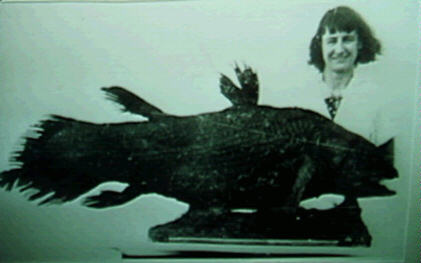| << Chapter < Page | Chapter >> Page > |
Some scientists consider Archaeopteryx to be a transitional fossil between dinosaurs and birds. Other scientists disagree. Below are two arguments given by scientists to support their interpretation that Archaeopteryx is not a transitional fossil between dinosaurs and birds. For each of these arguments, state whether the scientists are questioning the DATA, or the CONCLUSIONS about the Archaeopteryx fossil.
These scientists are questioning the DATA / CONCLUSIONS made by other scientists about Archaeopteryx .
These scientists are questioning the DATA / CONCLUSIONS made by other scientists about Archaeopteryx .
These scientists are questioning the DATA / CONCLUSIONS made by other scientists about Archaeopteryx .
In 1938, an East London fisherman caught a deep-sea fish he had never seen, so it was taken to the East London museum, where it was identified as a coelacanthby Professor JLB Smith and his assistant, Marjorie Courtenay-Latimer. This caused an international uproar, because the fish was previously known only fromfossils and had been believed to be extinct. People were amazed that fossil coelacanth found in rock strata 70 –350 million years old could look exactly like the large blue fish before their eyes! This started a search for more specimens and 14 years later, another one was caught off the Comoro Islands inthe Indian Ocean, north of Madagascar and more have been found since, including in deep crevices at St. Lucia in northern KZN.


Scientists agree that the coelacanth is probably the oldest living vertebrate and they are thought to be closely related to the freshwater fish that is seenas the ancestor of all land animals. The coelacanth’s internal organs are in many ways similar to those of amphibians, which are the earliest life formsto have colonized land. Unlike amphibians, its spine is supported by a permanent notochord, a cartilage and oil tube – it never develops a bony vertebral column like other fish do. The body is lobe-finned, not ray-finned like modern fish,although it is not known to “walk” on the ocean floor. Many scientists had thought that the coelacanth’s fins looked like“legs” (it was referred to as ‘old four legs’) and that it was in the process of developing limbs for use on land, but here was aspecimen, millions of years later, that still had the same fin structure. Its nostrils are also not blind-ending as in fish; they open into the mouth and can be used for breathing.

Notification Switch
Would you like to follow the 'Siyavula: life sciences grade 10' conversation and receive update notifications?